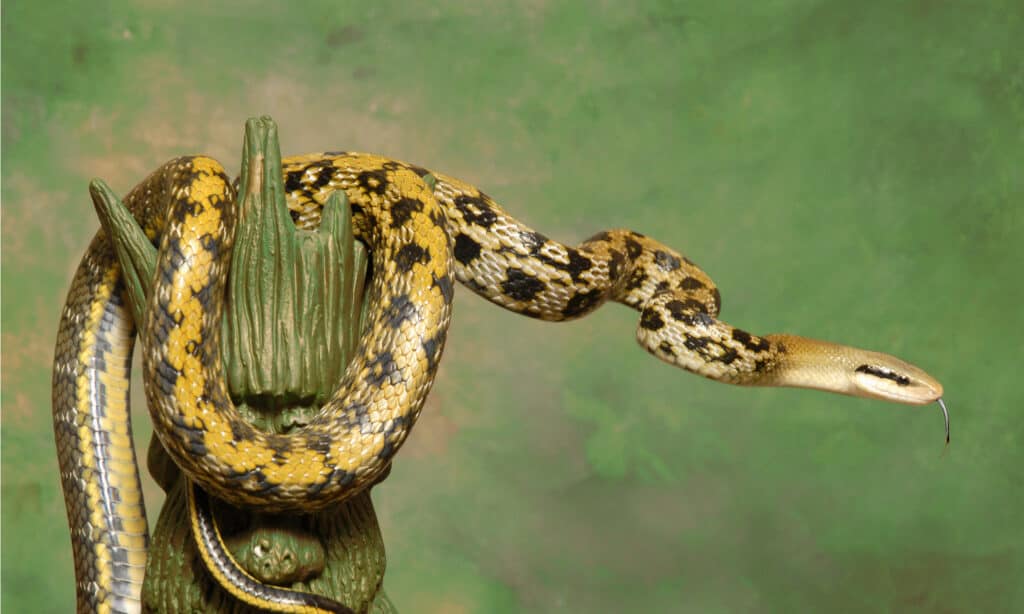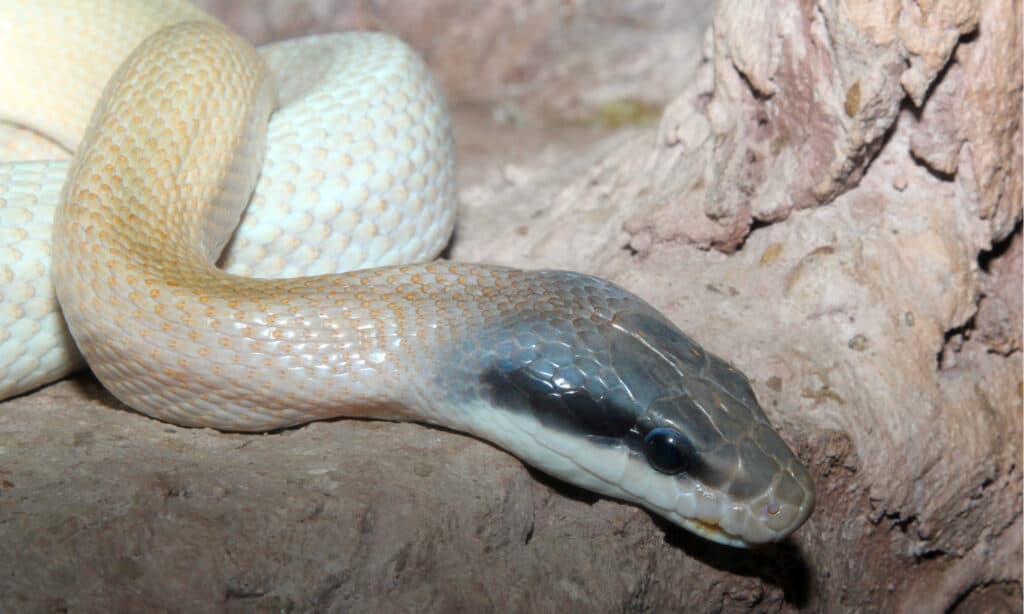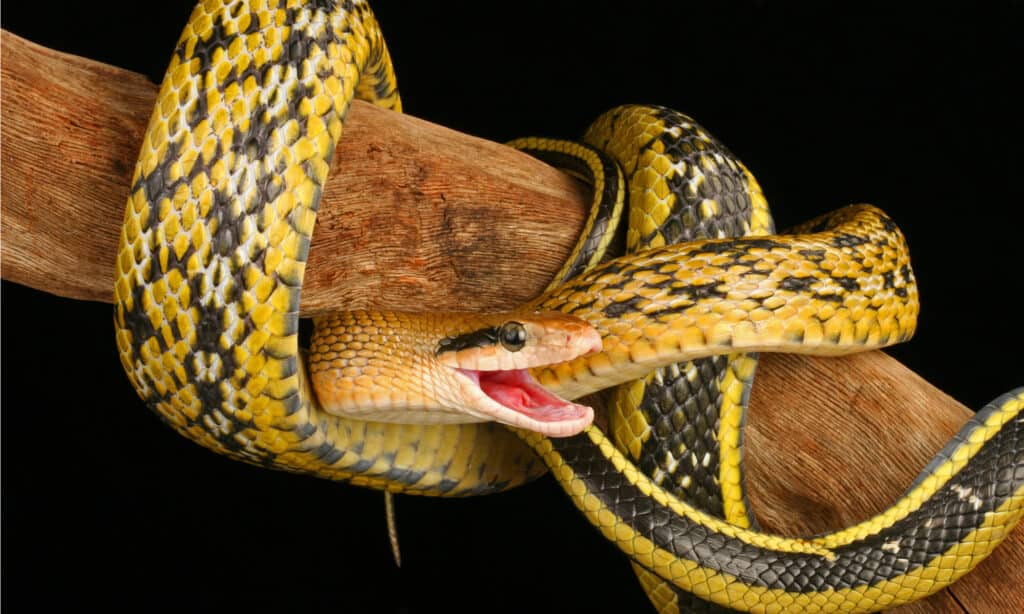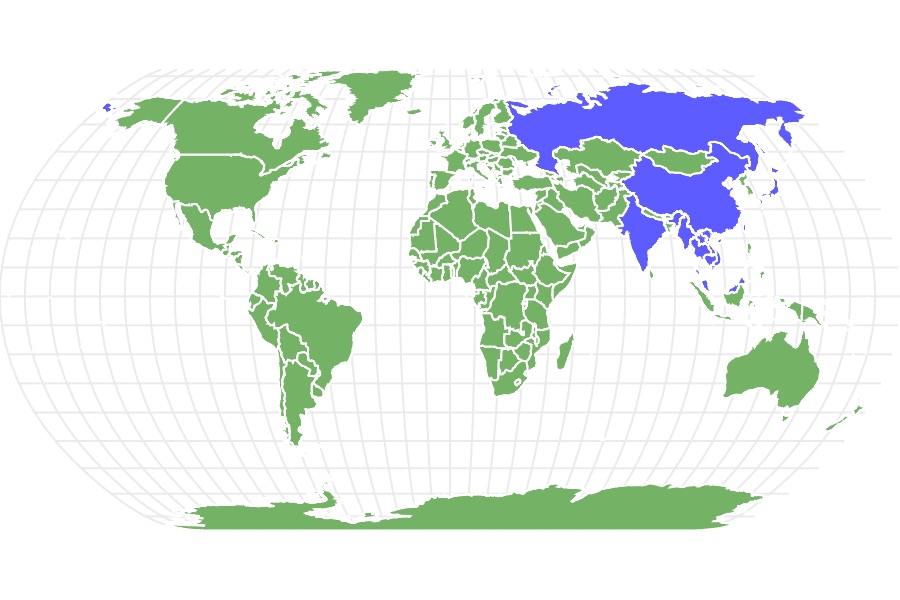Beauty rat snake
Orthriophis taeniura
Beauty Rat Snakes are relatively harmless if left undisturbed, only attempting to bite out of fear.
Advertisement
Beauty rat snake Scientific Classification
- Kingdom
- Animalia
- Phylum
- Chordata
- Class
- Reptilia
- Order
- Squamata
- Family
- Colubridae
- Genus
- Orthriophis
- Scientific Name
- Orthriophis taeniura
Read our Complete Guide to Classification of Animals.
Beauty rat snake Conservation Status
Beauty rat snake Facts
- Prey
- Rodents
- Group Behavior
- Solitary
- Solitary except during mating season
- Fun Fact
- Beauty Rat Snakes are relatively harmless if left undisturbed, only attempting to bite out of fear.
- Litter Size
- 4-12 eggs
- Diet for this Fish
- Carnivore
- Lifestyle
- Nocturnal
- Diurnal
- Crepuscular
- Common Name
- Beauty rat snake, beauty ratsnake, beauty snake, or cave racer.
View all of the Beauty rat snake images!
The beauty rat snake is quite a sight to see, and they are often praised for their ability to eliminate unwanted critters.
They aren’t venomous, but they have a bite that can take out their prey. You won’t find them naturally outside of eastern Asia, but you might be able to purchase them as a pet from a local store. Plus, it has quite a long lifespan if cared for properly.
5 Amazing Beauty Rat Snake Facts!
- The main food source for the beauty rat snake is rodents, like rats and mice. If they have the opportunity, they will also use their climbing skills to get to bats. Some pet owners feed their snakes baby chicks instead of live rodents.
- The average clutch size of the beauty rat snake is 4-12 eggs, requiring about 70 days of incubation before the baby snakes are born.
- The first shedding of the baby beauty rat snakes is two weeks after birth. The baby will grow to be at least four feet long before they mate.
- The natural predators of beauty rat snakes are birds and mammals. So far, there is no animal that strictly eats a diet of these snakes.
- Most people who have beauty rat snakes in their yards and gardens will let them stay as a natural form of pest control. Plus, they are relatively harmless if left undisturbed, only attempting to bite out of fear.
Where to Find Beauty Rat Snakes
While beauty rat snakes are spread generously through many areas of eastern and southeastern Asia, the specific countries that it is found in will depend entirely on the subspecies. While some snakes of this species are found in Taiwan, others are only found in certain areas of Japanese islands. Most people have no problem finding them on their own property because they act as natural pest control with their proclivity for a rodent-based diet. Due to the pet trade and the market for rat snakes, the beauty rat snake has become an invasive species within this same area.
The beauty rat snake prefers to live in caves, and their climbing skills allow them to glide effortlessly along the walls. They can hunt rats easily with this skill. Rather than staying up at a specific time of day in this habitat, these snakes will hunt at any time of day, regardless of the light.
Beauty Rat Snake Scientific Name
The beauty rat snake, which is sometimes called the beauty rat snake or cave racer, has the scientific name Orthriophis taeniura, which is Greek. The genus – Orthriophis – comes from a combination of two Greek words – “orthros” (“dawn”) and “ophis” (“snake”). The word “taeniura” is based on two Latin words – “taenia” (“stripe”) and “oura” (“tail”).
Its class is Reptilia, and it belongs to the Colubridae family.
The 10 Different Types of Beauty Rat Snakes
There are multiple variations of the beauty rat snake. In total, there are 10 subspecies, though little is known about all of them. The subspecies include:
- Chinese beauty snakes: The Chinese beauty snake lives in Russia with 11 different variations.
- Ridley’s beauty snakes: Also known as the cave-dwelling rat snake and the cave racer, this subspecies is on the Species Red List in China, and it is bred in the Cameron Highlands.
- Mocquard’s beauty rat snakes: These snakes are found in southeastern China and northern Vietnam. They are also found in Hainan.
- Taiwan beauty snakes: These snakes are only native to Taiwan. They are also known as stripe tail rat snakes.
- Vietnamese blue beauty snakes: These snakes are primarily found in Vietnam, but they are also located in Cambodia and Thailand naturally.
- Helfenberger’s beauty snakes: These snakes live in Thailand and Myanmar.
- Orthriophis taeniura grabowskyi: These snakes have primarily been found in Sumatra, East Malaysia, and Kalimantan.
- Orthriophis taeniura schmackeri: This species is only found in the Ryukyu Islands, which are located in Japan.
- Orthriophis taeniura yunnanensis: Primarily, you’ll see this species in Vietnam, China, India, Laos, Myanmar, and eastern Thailand.
- Orthriophis taeniura ssp.: These snakes are found in the Republic of the Union of Myanmar, Vietnam, and Thailand.
Beauty Rat Snake Population & Conservation Status
While the exact population of beauty rat snakes is unknown, the IUCN sees the species as Vulnerable. The species is invasive to certain areas of Asia, though it is native to other Asia countries. The market for these snakes is broad, threatening the species without adequate protection.
How to Identify a Beauty Rat Snake: Appearance and Description

©Blue Iris/Shutterstock.com
The beauty rat snake is quite long, reaching nearly 6 feet long among some subspecies. There are even one subspecies that can grow up to 7 or 8 feet long. The biggest one on record was just under 9.2 feet long, named Obi One Kenobi. The body of the beauty rat snake ranges from yellowish-brown to an olive green hue, though the tail is darker than the head. Along the back, you’ll see two pairs of black spots, though the head and neck have no pattern. In a crisp line that starts at the back corner of the eye, the stripe goes all the way across the mouth to the same place on the other side of the head. The mouth instead is a pale cream color.
With so many different species, their coloration can change between the species. The Chinese beauty snake, for example, is usually on the yellow side, but it may be white or albino as well. The Japanese rat snake, however, is completely white, featuring the typical red-eye associated with albino snakes.
How to identify a beauty rat snake:
- Olive green to yellowish-brown body with pairs of black spots.
- Sometimes found in white or albino.
- Up to 6 feet long.
- Pale mouth.
- Stripe across the mouth that extends to behind the eye.
Beauty Rat Snake Pictures

©Michal Sloviak/Shutterstock.com

©Audrey Snider-Bell/Shutterstock.com
Beauty Rat Snake: How Dangerous Are They?
While the Beauty Snake is not venomous, that doesn’t mean that they are completely harmless. The hunting technique of this snake involves constricting and biting its prey. Their diet is almost exclusively rodents, and they tend to keep to themselves. Their bite might hurt you, but medical care is minimal (at best).
Beauty Rat Snake Behavior and Humans
When it comes to humans, the beauty rat snake is mostly traded as a pet or for its skin. It is rather calm in temperament, making it a great pet and rather harmless to encounter. The snake is primarily bred in captivity if it is sold as a pet. Animals who are captured won’t adjust well to life as a pet.
Similar Animals
View all 284 animals that start with BBeauty rat snake FAQs (Frequently Asked Questions)
Are beauty rat snakes venomous?
No. The beauty rat snake is not venomous, but it will still bite a human if threatened. More than likely, they’ll slither away out of fear of getting caught instead as they are rather shit and docile. Their bite is painful as a result of bacteria, but there’s no venom that users have to worry about.
How big do beauty rat snakes get?
The average beauty rat snake can reach a size of 4-6 feet when fully grown.
Do beauty snakes make good pets?
The only way that anyone should own a beauty snake as a pet is if they already know how to handle them. Most species don’t require much care, though attention to their humidity levels and heat is necessary. They also need the right food, water, light, and housing in their tank to thrive.
How big do Vietnamese blue beauty snakes get?
The Vietnamese blue beauty snake reaches 6-7 feet long, which is much bigger than the average beauty snake subspecies.
Thank you for reading! Have some feedback for us? Contact the AZ Animals editorial team.
Sources
- Wikipedia / Accessed April 24, 2022
- Branson's Wild World / Accessed April 24, 2022
- Live Science / Accessed April 24, 2022
- Wikipedia / Accessed April 24, 2022
- Once in a Wild / Accessed April 24, 2022
- Northampton Reptile Centre / Accessed April 24, 2022
- Hong Kong Snake ID / Accessed April 24, 2022


















